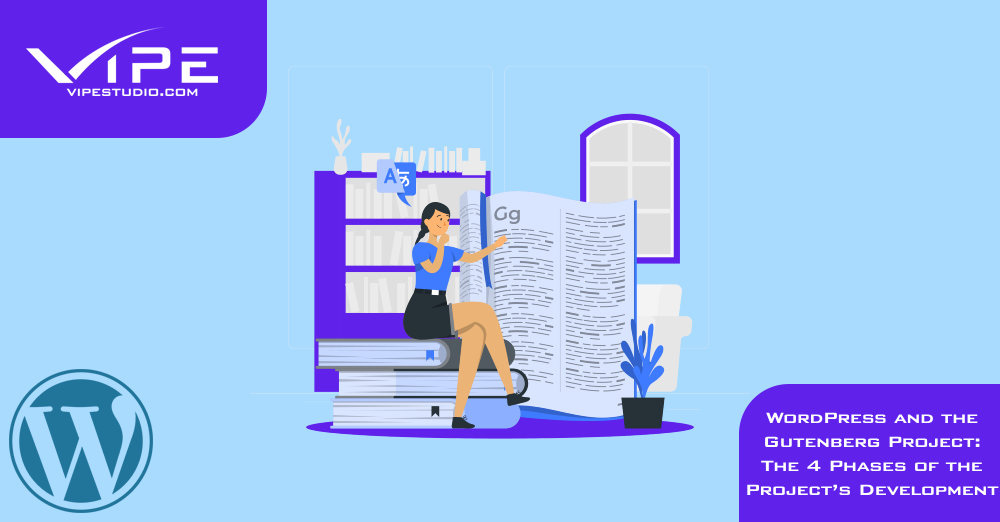31.07.2023
WordPress Development
WordPress and the Gutenberg Project: The 4 Phases of the Project’s Development
READING TIME: MIN
Table of Content
Hey, all! How’s the summer going? Our Enterprise WordPress Agency for Development is just tuning in, checking how everybody is doing. And since it’s summer, we can’t help but remind you that August 8th is approaching – a date of incredible importance for WordPress, its worldwide community and the Gutenberg Project.
In case you’ve missed the big news, we’ve got you covered: On August 8th the entire WordPress community is anticipating the launch of the CMS’s second major release this year – WordPress 6.3 is peaking around the corner and we bet it has a lot to offer in terms of improvements, fixes and updates.

Of course, as tradition has it, our team is preparing a full in-depth article that will tell you all about what’s new in the 6.3 release – until then, if you want to track WordPress’s progress so far, you can stop by and read our 6.2 and 6.1 entries. Yes, it’s indeed a top-notch warm-up experience!
Today’s article, however, revolves around the main character, at least in the last several WordPress released updates – the Gutenberg Project is certainly the centerpiece as it’s making its way through its initial 4-phase plan. And since WordPress 6.3 has a lot to offer in terms of Gutenberg upgrades and improvements, our Enterprise WordPress Agency for Development decided it’s time we tell you all about Gutenberg’s history.
So buckle up and let’s dive into Project Gutenberg’s journey so far!
An Editing Experience Like Never Before
Everyone who is familiar with and loves WordPress knows the story of its origin – initiated as a blogging platform, nowadays the CMS powers over 40% of the world’s websites. And even though it managed to surpass its initial purpose, it’s no wonder that its essence is still heavily intertwined with the art of creating and editing.
At first, users welcomed the WordPress classic editor – a neat and seamless blogging solution that missed, however, a smooth transient approach and intuitive editing experience.
Welcome, Gutenberg!
Then WordPress took a step further – the Gutenberg editor was first released in 2018 and introduced to the world in WordPress 5.0. It quickly became known as the block editor – each piece of blog content was a block that you could edit and modify the way you want. It gained popularity quite quickly as it offered a more intuitive approach to the way content was constructed and edited.

This transition wasn’t surprising at all – one of WordPress’s goals is to provide an elevated level of website usage and content distribution where “what you see is what you get”.
Essentially, that’s what Gutenberg represented – its infamous drag-and-drop feature truly was a game-changer when it came to how users constructed and edited content and the intuitive approach made content management more dynamic and authentic than ever!
But WordPress’s plan doesn’t stop there: The ultimate goal is to turn Gutenberg into a handy tool that has the potential to forever change the way users (even those who lack any technological background whatsoever) approach and maintain their websites. The end goal was to reach a level of full website editing experience, not only blog posts and written content.
The WordPress team knew that, in order to achieve this much-anticipated game-changing goal, a plan that lays the fundamentals is needed. Gutenberg had to undergo an extensive development cycle and the WordPress developers decided to gradually improve its functionalities by the power of regular updates. And that’s how we ended up with the 4 phases of the Gutenberg Project.
Discovering the 4 Phases of the Gutenberg Project
WordPress is the world’s most popular content management system – starting out as a blogging platform, the CMS quickly reinvented its whole purpose – reevaluating full website editing and how content is being constructed and distributed.
Even its name has a lot to disclose when it comes to its long-term goal: The WordPress block editor is named after Johannes Gutenberg – the man who invented the printing press and forever changed the way people gain access to and distribute content around the world. Our Enterprise WordPress Agency for Development can’t think of a better name that fully encompasses what the editor experience is all about!
And since going from a block content editor to a full website editing experience is a long way, the Gutenberg development team came up with 4 phases that intuitively followed the editor’s progress. From WordPress 5.0 to this day, each official release offered a plethora of improvements and upgrades whose initial plan was to move the project further in its 4-step development journey.
Here’s a quick overview:
Phase 1 – Easier Editing
WordPress’s forte, right from the get-go, was the seamless, easy and intuitive content creation. So it’s no wonder that the very first phase of the project’s development delved around the topic of easier editing.
Luckily, this feature was introduced in WordPress 5.0 back in 2018 when the Gutenberg editor was first launched. It offered plenty of improvements in contrast with the classic WordPress editor and made it possible for users to get their hands on the infamous drag-and-drop feature that changed the way we wrote and edited content and pages.

Each piece of content being a separate block gave users the freedom to tackle intuitive editing and content creation and add plenty of segments and integrations without the need for excessive coding and tech knowledge.
Phase 2 – Customization and Gutenberg
As WordPress’s development team has put it, phase 2 of the Gutenberg Project Roadmap focused on delivering outstanding customization features that go way beyond blogs and articles. It mainly had the goal to deliver:
- Full site editing – Gutenberg blocks were destined to surpass their original purpose as integrative elements of the blogging experience and make their way to the overall website as well;
- Block patterns – predefined layouts made out of Gutenberg blocks which preserved their easy-editing nature;
- Block directory – enabling easier and faster testing of block-based extensions and plugins for an elevated website experience;
- Block themes – a collection of blocks that powers the way your website looks, feels and behaves when interacted with;
The second phase promises even more elevated user freedom as users will benefit from more intuitive and easier editing and website maintenance without much coding and precise tech engineering.
Phase 3 – Collaboration
If there’s anything that gives the feeling of top-notch professional editing experience, it’s co-author editing. Our Enterprise WordPress Agency for Development bets you are familiar with the way multiple users can edit and participate in the creation of a single Google Docs document. Now, imagine the same being introduced to the WordPress editing experience.
Multiple authors’ collaboration is yet another step further to ensuring dazzling web development and user experience.
Phase 4 – Multilingual
The multilingual feature is incredibly important when it comes to scalability and enterprise growth. The fourth stage of the project’s development tackles a crucial aspect of web development.

Core implementations to WordPress’s and Gutenberg’s cores are destined to forever change the way users maintain and develop their multilingual platforms. This promises official translation support for websites and has the potential to diminish the translating plugins’ usage. As we all well know, sometimes plugins have the potential to slow down a website due to their excessive coding. The last thing a high-traffic website needs is speed and performance issues.
Gutenberg Is Definitely Here to Stay – Trust Vipe Studio to Experience the Editor’s Multitude of Possibilities
Have you checked out our Custom Gutenberg Blocks services? Our team is fully embracing the editor’s plethora of possibilities and benefits and is eager to help you get the most out of your website’s editing experience!
Don’t hesitate to reach out and talk to us – our experts will evaluate your needs and offer the best solutions in terms of custom WordPress development. We’re waiting!
More on The Topic
- Scaling WordPress Without Losing Culture
- WordPress 6.9 “Gene”: What This Release Really Changes
- Managing Gutenberg Chaos at Scale
- The Real Difference Between Managed and Developer-Oriented Hosting
- WordCamp Sofia 2025: A Full Recap of Bulgaria’s Biggest WordPress Event
Tags: Block Editorfull website editingGutenbergGutenberg projectmultilingual WordPress
The content of this website is copyrighted and protected by Creative Commons 4.0.



